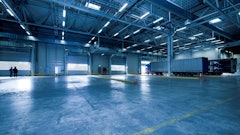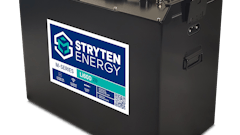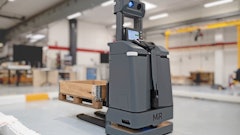
Many of today’s food warehouses are in need of new racking systems. As companies grow, the need to better utilize space becomes increasingly apparent. The ideal racking system should not only create greater storage density, but also be strong, long-lasting and help reduce your workforce.
As is the case with all operations upgrades, the more efficiency they drive the more expensive they can be. But choosing a racking system based on sticker price alone is only looking at half the picture. Choosing the right system means narrowing down the most critical areas that need improving in the distribution center, and choosing a system that will meet those needs at an affordable price.
One of the first crucial decisions to make is how durable and strong a racking system is needed.
Cold Roll-Formed Vs. Structural
There are two basic categories of steel racking: structural steel and cold roll-formed steel. The difference lies in how the raw material (recycled steel from vehicles, appliances, etc.) is processed. Each has its own set of advantages and disadvantages, and the two materials can be used in combination to achieve the desired durability at a lower price point.
Structural steel racks are formed by heating steel into a liquid, and then forming it through rollers. Racking beams and frames made in this fashion are solid steel throughout, and thus stronger and more durable than the alternative.
Carlos Oliver, president of Frazier Industrial, Long Valley, NJ, says durability is key in food warehouses.
“Due to the fast pace of operations [in food warehouses], forklifts colliding with racks are quite common and can cause serious damage to the rack,” says Oliver. “Frazier only manufactures structural steel because we believe it is more durable and can better withstand those kinds of hits.”
Cory Flemings, executive sales manager, automated systems division, of Schaefer Systems International Inc., Charlotte, NC, agrees that structural steel has better resistance to buckling than cold roll-formed steel; however, he explains that the product isn’t without limitations.
“I-beams and posts are still hot when they’re formed and as they cool off they can change shape slightly,” says Flemings. “The ability to predict the exact shape of the rack may be difficult because it’s a less accurate process.”
The cold roll-formed steel manufacturing process begins with a cold sheet of steel. The sheet is then run through a 300- to 400-meter-long machine that bends the steel into hollow posts. The sheet is bent multiple times along each of the sides to add strength and durability.
One advantage of cold roll-formed steel is that it costs less by requiring fewer raw materials.
“They’re less expensive, but just as strong from a structural standpoint,” says Flemings. “Each bend gives it more strength, and our beams have about 20 bends in them. However, the difference is that the thinner gauge allows it to buckle when it takes a larger blow than it was designed to withstand.”
Although most racking manufacturers offer exclusively cold roll-formed or structural steel racks, Steel King Industries Inc., Stevens Point, WI, manufactures both, and even offers the two materials in the same rack.
“We recognize that there are various advantages to each, and we like to offer our customers strength and durability while remaining economical,” says Kurt Larson, central regional sales manager of Steel King. “Using both cold roll-formed and structural steel allows us to give them that option.”
Larson explains that many food companies prefer to use structural steel because of its added durability, but since forklift collisions usually occur with the frame as opposed to the beam, the company uses cold roll-formed (less durable) steel for the beams. This allows them to use fewer raw materials and save money, while providing the right amount of strength where it’s needed most.
Selecting The Right Rack
No matter what type of steel they’re made of, the functionality of a rack is based on the type of storage system employed. There are several different options, and most of the major rack manufacturers provide their own versions of all of them. Three of the most well-known are selective, drive-in and push-back.
A selective rack system can effectively get the job done in most foodservice distribution centers. The system operates by storing one pallet per position at a time. When an order is submitted, workers drive down the aisles with a pallet jack and place the items from the order list onto the pallet. Once all of the items ordered are picked, the pallet is dropped off at the back door and awaits shipment to the customer.
These racking systems are generally lower-priced, but they make it difficult to achieve optimal product density. A poorly designed selective racking system may leave 30 to 50 percent of your storage positions empty, according to Frazier’s Oliver.
Drive-in racking systems are among the least used in grocery distribution centers; however, they do have a place in the market. One advantage to drive-in racking systems is that it allows for greater storage density than the selective rack system.
When using this model, all pallets from floor to ceiling and front to back must be the same SKU. This is because of the replenishment process, which requires lift trucks to work from the outside in. The entire row must be empty before replenishment can occur.
The most efficient racking system for grocery distribution, agrees Oliver and Flemings, is the push-back or glide-in racking system.
The rack itself sits atop a platform with wheels. The floor has railroad-like tracks embedded in it, so the racks can be pushed close to one another and eliminate the aisles between them.
“The advantages are incredible,” says Flemings. “The storage density, especially in frozen applications, is very important. For example, green beans are only grown in the summer and once harvested, they are immediately flash frozen and sent to a warehouse for storage. You can use the mobile racking system to close up the aisles where they’re stored and sell them off from October until mid next summer without having to take up large amounts of space.”
Oliver says this method of racking is the most expensive of the three, but when you’re paying by the square foot, or for each cubic foot of frozen or air conditioned air, it quickly becomes apparent how paying a premium for added storage density can pay off in the long run.
Storage is an integral part of a distribution center’s success, but it’s not the only factor that can lead to increased throughput. Utilizing automatic storage retrieval systems, or AS/RS racking, can also improve operations and productivity immensely.
Automation Advantage
In the mid-1970s the distribution industry was introduced to a new type of racking systems: AS/RS. The system uses automated cranes that run along a railroad track in the middle of the aisles and precisely picks items to place onto a pallet. The crane arm can extend out to either side of the aisle to pick up or retrieve a pallet.
Oliver says Frazier’s AS/RS was popular into the 1980s, but demand softened for awhile as conventional racking systems began to reach higher heights. Although the concept has changed little over the years, the AS/RS market has recently made a comeback across warehouses worldwide.
One advantage to using such a system is the ability to reduce your workforce and the overhead costs associated with it such as wages, employee benefits and workers’ comp claims.
“Because of the price of labor and unionization and the dialogue in the federal government with respect to healthcare, more and more companies are going to turn to automation to maintain high productivity at low costs,” says Oliver.
In addition to labor savings, using an AS/RS eliminates shrink, human error and the risk of forklift collision, while enabling more accurate inventory control.
“The capital investment for an AS/RS racking system is significant,” adds Steel King’s Larson. “The costs can be in the millions, but it’s a controlled cost that will eliminate future overhead costs,” he says.
According to Flemings, there is a specific threshold where once reached, a company should seriously consider utilizing an AS/RS.
“When you reach 10,000 pallets in storage you need to start thinking about an AS/RS,” he says. “When you’re space-constrained and you need to store more than you have space for, it’s time to start thinking about going up with storage retrieval systems that uses all your vertical space.”
Safety Considerations
One area where it’s never acceptable to be thrifty is safety. Different racks have different shelf lives, and according to Oliver, the typical structural steel rack lasts up to 20 to 30 years, while most cold roll-formed steel racks last approximately five to 10 years. When their shelf life expires, it is essential to replace them, or have the original manufacturer repair them, no matter what the investment is. Keeping old racks or ill-repaired racks can result in failure, extensive product damage and even loss of life.
Purchasing used rack is an offense Larson often sees.
“Mixing used rack with new rack is a huge concern,” says Larson. “Be very careful when considering used rack. The history and condition of the rack doesn’t have to be disclosed before you buy it so if anything were to happen in the distribution center, the responsibility would rest on the facility manager. New racks can be a hefty investment, but the insurance of having undamaged racks outweigh the risk of using compromised ones.”
Oliver urges facility managers to resist the temptation to re-profile, or reconfigure racks in an attempt to gain storage density. Arranging the beams and frames in any combination other than the original design can cause critical rack failure.
“Every facility should have a set of drawings with the approved system and a placard stating what load it was designed for and the approved elevation the rack frames were made for,” says Oliver. “The general manager of the facility should have that information at his disposal and should be consulted before anybody moves any portion of their racking system.”
Using the right racking system can reap a host of benefits including maximization of storage density, faster throughput and workforce reduction. Armed with the knowledge of racking basics, finding the right system for your company’s changing needs should be possible at any price point with the variety of options available today.

























